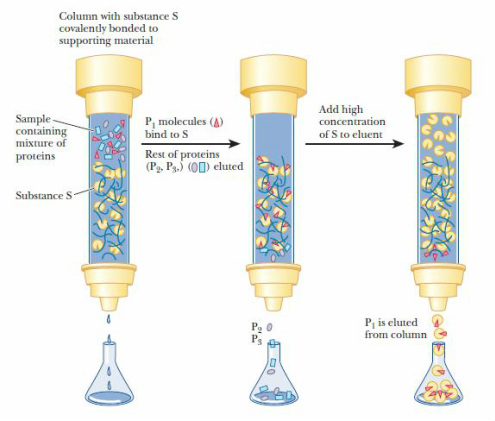
Affinity Chromatography
 المؤلف:
John M Walker and Ralph Rapley
المؤلف:
John M Walker and Ralph Rapley
 المصدر:
Molecular Biology and Biotechnology 5th Edition
المصدر:
Molecular Biology and Biotechnology 5th Edition
 الجزء والصفحة:
الجزء والصفحة:
 15-1-2021
15-1-2021
 1875
1875
Affinity Chromatography
Applied correctly and with the appropriate ligand, affinity chromatography is the most powerful chromatographic purification method available to yield high purification factors in a single step. Due to the high biospecificity of this approach, it is used as a fundamental capture
step in most processes where an appropriate ligand is available and this is one of the limitations in using the approach. The approach is thus based upon the affinity of the target molecule for a ligand immobilised on an appropriate resin. Protein A capture of monoclonal antibodies expressed from in vitro cultured mammalian cells is one of the most widely used affinity chromatography steps. Indeed, industrially the gold standard purification of monoclonal antibodies is to use protein A chromatography as the first step in the purification process after primary recovery steps. For example, in 2002 the demand for protein A resins exceeded 10 000 L and an already $50 million a year market was growing at a rate of 50% per year.However, increased yields of recombinantly produced monoclonal antibodies coupled with the high cost of protein A resins mean that investigators are currently focused upon improving the capacity and throughput of this approach in order to continue making this approach economical. A further area of concern with the use of protein A is the stability of these resins upon cleaning, and therefore there is much interest in finding alternatives to protein A chromatography for antibody purification.
A number of other affinity ligands are also used at the industrial and laboratory scale. Dye-based ligands are perhaps the largest industrially utilised approach, largely for the purification of industrially produced enzymes. Immobilised metal affinity chromatography is also widely used at the laboratory scale, particularly the use of poly His-tags, whereby the target protein of interest is engineered to contain a His-tag usually of six consecutive His residues at either the C- or N-terminal end of the protein. This approach is popular due to the high binding capacity,
stability, robustness and recovery offered by poly His-tags.However, a drawback of such an approach is that it is often necessary to remove the His-tag during bioprocessing to maintain the authenticity of the biomolecule, adding further steps and costs to the process. It is therefore
most widely applied to high-throughput research approaches where there is a need to purify a large number of different proteins for further study.
Although the development of affinity separations is one of enormous potential, the growth of regular packed bed affinity chromatography seems to have plateaued over the past few years. The limitations do not lie in affinity�based separations but in packed bed chromatography columns and the lack of cheap ligands available for use at an industrial scale. The recent development of the Capture Select technology by BAC and GE Healthcare is a new approach for designing/developing novel ligands. This technology uses a unique antibody found in Camelidae, specifically a small 12 kDa antigen�binding fragment, to develop customised ligands which can be used for purifying recombinant proteins, scavenging impurities and removing viral load from complex media using an animal free system. This approach offers optimal binding affinity coupled with a high specificity over a broad range which allows the step to be fine tuned for a given process by incorporating specific elution conditions and stability. The technology has not yet become widely adopted at the industrial scale but offers an alternative method to affinity chromatography development. Other alternatives, such as affinity precipitation, expanded bed adsorption and affinity membrane chromatography, are therefore currently being investigated as possible replacements.

 الاكثر قراءة في مواضيع عامة في التقانة الإحيائية
الاكثر قراءة في مواضيع عامة في التقانة الإحيائية
 اخر الاخبار
اخر الاخبار
اخبار العتبة العباسية المقدسة


